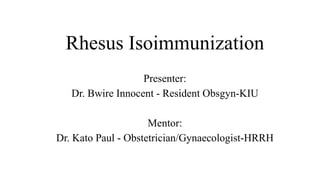This document discusses Rhesus isoimmunization, which occurs when a Rh-negative mother develops antibodies against Rh-positive fetal red blood cells. It covers the epidemiology, pathophysiology, causes including the "grandmother effect", investigations such as the Kleihauer-Betke and Coombs' tests, management of sensitized mothers through surveillance and potential fetal transfusions, and treatment of affected newborns including phototherapy and exchange transfusions. Prevention relies on administering Rhogam prophylaxis to unsensitized Rh-negative mothers.
























![Direct Coombs’ Test
• used to detect these antibodies or complement proteins that are bound
to the surface of RBC.
• A blood sample is taken & the RBCs are washed & then incubated
with antihuman globulin[also known as coombs’ reagent].
• If this produces agglutination [clumping together] of RBCs, The
Direct Coombs’ Test Is Positive.](https://image.slidesharecdn.com/rhisoimmunizationbwire2-231107175505-d5342f19/85/RH-ISOIMMUNIZATION-BWIRE2-pptx-25-320.jpg)






















